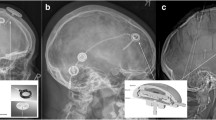Abstract
The authors present the policy they have worked out for hydrocephalus patients with special reference to the pressure measurement and test methods and to rCBF, SPECT and transcranial Doppler sonography (TDC) studies. For diagnosis, the protocol proposed by Gjerris and Borgesen was followed in 75 cases: besides other methods (CT, radionuclide cisternography, MRI) the intracranial pressure waves routinely recorded and analyzed by means of ventricular catheters for 24 h. The patients were roughly divided into groups in terms of diagnosis, baseline pressure, compliance, results of infusion tests and of surgery. In 13 patients the investigations were supplemented by rCBF SPECT and in 42 patients by TCD studies before and after CSF shunting or withdrawal to analyze the acute effects on cerebral circulation. Clinical follow-up shows that need for shunting was indicated fairly well by the common results of baseline ICP, compliance and infusion loading. The rCBF SPECT studies revealed a significant increase of the cerebral perfusion at the basal ganglia after shunting while, on the basis of CBF velocity changes three types of vasoregulatory response could be defined with TCD. In our hands, monitoring of the pressure and craniospinal capacity has proved to be a valuable aid in decisions on surgery; however, for a more precise (and beneficial) appreciation of whether surgery is indicated the vasoregulatory responses should also be taken into account in future.
Similar content being viewed by others
References
Bradley W, et al (1991) Marked cerebrospinal fluid void: indicator of successful shunt in patients with suspected normal-pressure hydrocephalus. Radiology 178:459–466
Gjerris F, Borgesen SE, Schmidt J, Sorensen PS (1989) Resistance to cerebrospinal fluid outflow in patients with normal pressure hydrocephalus. In: Gjerris F, Borgesen SE, Sorensen PS (eds) Outflow of cerebrospinal fluid. Munksgaard, Copenhagen, pp 329–338
Hasan D (1989) Management problems in acute hydrocephalus after subarachnoid hemorrhage. Stroke 20:747–753
Hasan D (1991) Single photon emission computed tomography in patients with acute hydrocephalus or with cerebral ischaemia after subarachnoid haemorrhage. J Neurol Neurosurg Psychiatry 54:490–493
Hunt WE, Hess RM (1968) Surgical risk as related to time of intervention in the repair of intracranial aneurysms. J Neurosurg 28:14–20
Hussey F, Schanzer B, Katzman R (1970) A simple constant-infusion manometric test for measurement of CSF absorption, I and II. Neurology 20:534–544, 665–680
Kasuya H (1991) The effect of continuous drainage of cerebrospinal fluid in patients with subarachnoid haemorrhage: a retrospective analysis of 108 patients. Neurosurgery 28:56–59
Lundberg N (1960) Continuous recording and control of ventricular fluid pressure in neurosurgical practice. Acta Psychiatr Neurol Scand 36 [Suppl 149]:1–193
Marmarou A, Shulman K, LaMorgese J (1975) Compartmental analysis of complicance and outflow resistance of the cerebrospinal system. J Neurosurg 43:523–534
Marmarou A, Shulman K, Rosende RM (1978) A nonlinear analysis of the cerebrospinal fluid system and intracranial pressure dynamics. J Neurosurg 48:332–344
Martins AN (1973) Resistance to drainage of cerebrospinal fluid: clinical measurement and significance. J Neurol Neurosurg Psychiatry 36:313–318
Milhorat TH (1987) Acute hydrocephalus after aneurysmal subarachnoid haemorrhage. Neurosurgery 20:15–20
Papo I, Bodosi M, Mérei F, Luongo A (1984) L'hydrocéphalie apres hémorragie sous-arachnoidienne. Neurochirurgie 30:159–164
Shigeki O (1988) MR imaging of CSF pulsatory flow and its relation to intracranial pressure. J Neurosurg 69:675–682
Author information
Authors and Affiliations
Rights and permissions
About this article
Cite this article
Kopniczky, Z., Barzó, P., Pávics, L. et al. Our policy in diagnosis and treatment of hydrocephalus. Child's Nerv Syst 11, 102–106 (1995). https://doi.org/10.1007/BF00303814
Issue Date:
DOI: https://doi.org/10.1007/BF00303814




